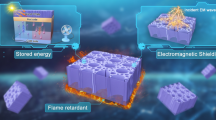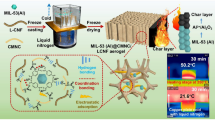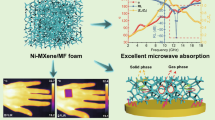Abstract
It is imperative to develop efficient flame retardants to solve the issues of high heat and smoke release for epoxy resin (EP) polymeric materials plagued over time. Hence, a phosphorus–nitrogen modified Ti3C2Tx MXene nanohybrids (MXene@MPA) were synthesized by in situ assembly melamine phytate macromolecules (MPA) to boost the fire hazards of EP composites. The introduction of MPA improved the dispersion of MXene in epoxy matrix, contributing to the improved thermal stability and flame-retardant properties for EP composites. With the addition of 2 mass% MXene@MPA, EP composites achieved the decreased maximum mass loss rate (MLRmax) by 41.8%, indicating the enhanced thermal properties. Also, the peak heat release rate (PHRR) and peak smoke production rate (PSPR) of EP-MXene@MPA composites were down by 27.9% and 43.6% compared to pure EP, respectively, accompanied by significantly increased char production. The synergistic effects between MPA and MXene contributed to the elevated fire safety of EP-MXene@MPA composites: the catalytic charring of transition metals and phosphorus-containing acid and the barrier effect of MXene nanosheets, as well as the quenching effects of phosphorus–oxygen free radicals and dilution of nitrogen-containing inert gases due to the decomposition of MPA. The multiple hybridization route provided a reference for the development of efficient MXene-based flame retardants.











Similar content being viewed by others
References
Zhang W, et al. The influence of the phosphorus-based flame retardant on the flame retardancy of the epoxy resins. Polym Degrad Stab. 2014;109:209–17. https://doi.org/10.1016/j.polymdegradstab.2014.07.023.
Huo S, et al. Phosphorus-containing flame retardant epoxy thermosets: recent advances and future perspectives. Progr Polym Sci. 2021;114:101366.
Cheng J, et al. Benzimidazolyl-substituted cyclotriphosphazene derivative as latent flame-retardant curing agent for one-component epoxy resin system with excellent comprehensive performance. Compos B Eng. 2019;177:107440. https://doi.org/10.1016/j.compositesb.2019.107440.
Yin L, et al. Flame-retardant activity of ternary integrated modified boron nitride nanosheets to epoxy resin. J Colloid Interface Sci. 2022;608:853–63. https://doi.org/10.1016/j.jcis.2021.10.056.
Wang Y, et al. Transparent, flame retardant, mechanically strengthened and low dielectric EP composites enabled by a reactive bio-based P/N flame retardant. Polym Degrad Stab. 2022;204:110106. https://doi.org/10.1016/j.polymdegradstab.2022.110106.
Lu J, et al. Designing advanced 0D–2D hierarchical structure for epoxy resin to accomplish exceeding thermal management and safety. Chem Eng J. 2022;427:132046. https://doi.org/10.1016/j.cej.2021.132046.
Meng W, et al. Assembling MXene with bio-phytic acid: Improving the fire safety and comprehensive properties of epoxy resin. Polym Testing. 2022;110:107564. https://doi.org/10.1016/j.polymertesting.2022.107564.
Zhang Z, et al. Temperature-responsive resistance sensitivity controlled by L-ascorbic acid and silane co-functionalization in flame-retardant GO network for efficient fire early-warning response. Chem Eng J. 2020;386:123894. https://doi.org/10.1016/j.cej.2019.123894.
Zhou K, Gao R, Qian X. Self-assembly of exfoliated molybdenum disulfide (MoS2) nanosheets and layered double hydroxide (LDH): towards reducing fire hazards of epoxy. J Hazard Mater. 2017;338:343–55.
Feng T, et al. 0D–2D nanohybrids based on binary transitional metal oxide decorated boron nitride enabled epoxy resin efficient flame retardant coupled with enhanced thermal conductivity at ultra-low additions. Compos Commun. 2023;41:101649. https://doi.org/10.1016/j.coco.2023.101649.
Xu W, et al. Nickel hydroxide and zinc hydroxystannate dual modified graphite carbon nitride for the flame retardancy and smoke suppression of epoxy resin. Polym Degrad Stab. 2020;182:109366. https://doi.org/10.1016/j.polymdegradstab.2020.109366.
Gong K, et al. MXene as emerging nanofillers for high-performance polymer composites: a review. Compos Part B: Eng. 2021. https://doi.org/10.1016/j.compositesb.2021.108867.
Gong K, et al. Novel exploration of the flame retardant potential of bimetallic MXene in epoxy composites. Compos B Eng. 2022;237:109862. https://doi.org/10.1016/j.compositesb.2022.109862.
Wan M, et al. Interface assembly of flower-like Ni-MOF functional MXene towards the fire safety of thermoplastic polyurethanes. Compos A Appl Sci Manuf. 2022;163:107187. https://doi.org/10.1016/j.compositesa.2022.107187.
Liu C, et al. Phosphorous-Nitrogen flame retardants engineering MXene towards highly fire safe thermoplastic polyurethane. Compos Commun. 2022;29:101055. https://doi.org/10.1016/j.coco.2021.101055.
Huo S, et al. A hyperbranched P/N/B-containing oligomer as multifunctional flame retardant for epoxy resins. Compos B Eng. 2022;234:109701. https://doi.org/10.1016/j.compositesb.2022.109701.
Luo J, et al. Killing three birds with one stone: a novel regulate strategy for improving the fire safety of thermoplastic polyurethane. Compos A Appl Sci Manuf. 2023;168:107491. https://doi.org/10.1016/j.compositesa.2023.107491.
Cheng X, et al. Phytic acid as a bio-based phosphorus flame retardant for poly(lactic acid) nonwoven fabric. J Clean Prod. 2016;124:114–9. https://doi.org/10.1016/j.jclepro.2016.02.113.
Shang S, et al. Facile preparation of layered melamine-phytate flame retardant via supramolecular self-assembly technology. J Colloid Interface Sci. 2019;553:364–71.
Ran S, et al. Synthesis of decorated graphene with P, N-containing compounds and its flame retardancy and smoke suppression effects on polylactic acid. Compos B Eng. 2019;170:41–50. https://doi.org/10.1016/j.compositesb.2019.04.037.
Yan W, et al. Novel bio-derived phytic acid and melamine interlayered/surface dual modified layered double hydroxide by one-pot method and its highly efficient flame retardant performance for polypropylene. Appl Clay Sci. 2022;228:106620. https://doi.org/10.1016/j.clay.2022.106620.
Yang W, et al. Self-assembled bio-derived microporous nanosheet from phytic acid as efficient intumescent flame retardant for polylactide. Polym Degrad Stab. 2021;191:109664. https://doi.org/10.1016/j.polymdegradstab.2021.109664.
Zhou K, et al. Facile strategy to synthesize MXene@LDH nanohybrids for boosting the flame retardancy and smoke suppression properties of epoxy. Compos A Appl Sci Manuf. 2022;157:106912. https://doi.org/10.1016/j.compositesa.2022.106912.
Zhan Y, et al. Flexible MXene/aramid nanofiber nanocomposite film with high thermal conductivity and flame retardancy. Eur Polymer J. 2023;186:111847. https://doi.org/10.1016/j.eurpolymj.2023.111847.
Wang K, et al. Construction of modified MXene with “organic–inorganic” structure to enhance the interfacial and mechanical properties of UHMWPE fiber-reinforced epoxy composite. Chem Eng J. 2023;452:139156. https://doi.org/10.1016/j.cej.2022.139156.
Peng H, et al. N-P-Zn-containing 2D supermolecular networks grown on MoS2 nanosheets for mechanical and flame-retardant reinforcements of polyacrylonitrile fiber. Chem Eng J. 2019;372:873–85. https://doi.org/10.1016/j.cej.2019.04.209.
Li W, et al. Highly efficient replacement of traditional intumescent flame retardants in polypropylene by manganese ions doped melamine phytate nanosheets. J Hazard Mater. 2020;398:123001. https://doi.org/10.1016/j.jhazmat.2020.123001.
Shi Y, et al. Interface engineering of MXene towards super-tough and strong polymer nanocomposites with high ductility and excellent fire safety. Chem Eng J. 2020;399:125829. https://doi.org/10.1016/j.cej.2020.125829.
Liu L, et al. Functionalizing MXene towards highly stretchable, ultratough, fatigue- and fire-resistant polymer nanocomposites. Chem Eng J. 2021;424:130338. https://doi.org/10.1016/j.cej.2021.130338.
Ma Y, et al. Green construction of melamine phytate nanosheets for enhancing anti-corrosive performance of water-borne epoxy coatings. J Mater Sci. 2022;57(7):4820–33. https://doi.org/10.1007/s10853-022-06940-3.
Guo F, et al. NiFe prussian blue analogue nanocages decorated magnesium hydroxide rod for enhancing fire safety and mechanical properties of epoxy resin. Compos B Eng. 2022;233:109650. https://doi.org/10.1016/j.compositesb.2022.109650.
Yin L, et al. Novel design of MOFs-based hierarchical nanoarchitecture: towards reducing fire hazards of epoxy resin. Compos A Appl Sci Manuf. 2022;158:106957. https://doi.org/10.1016/j.compositesa.2022.106957.
Gong K, et al. Construction of interface-engineered two-dimensional nanohybrids towards superb fire resistance of epoxy composites. Compos A Appl Sci Manuf. 2022;152:106707. https://doi.org/10.1016/j.compositesa.2021.106707.
Han G, et al. Flexible, thermostable and flame-resistant epoxy-based thermally conductive layered films with aligned ionic liquid-wrapped boron nitride nanosheets via cyclic layer-by-layer blade-casting. Chem Eng J. 2022;437:135482. https://doi.org/10.1016/j.cej.2022.135482.
Gong K, et al. Organic-inorganic hybrid engineering MXene derivatives for fire resistant epoxy resins with superior smoke suppression. Compos A Appl Sci Manuf. 2022;161:107109. https://doi.org/10.1016/j.compositesa.2022.107109.
Gong K, et al. Dual char-forming strategy driven MXene-based fire-proofing epoxy resin coupled with good toughness. J Colloid Interface Sci. 2023;640:434–44. https://doi.org/10.1016/j.jcis.2023.02.134.
Decsov K, et al. Microfibrous cyclodextrin boosts flame retardancy of poly(lactic acid). Polym Degrad Stab. 2021;191:109655. https://doi.org/10.1016/j.polymdegradstab.2021.109655.
Shi C, et al. Co-MOF@MXene hybrids flame retardants for enhancing the fire safety of thermoplastic polyurethanes. Polym Degrad Stab. 2022;204:110119. https://doi.org/10.1016/j.polymdegradstab.2022.110119.
Kong Q, et al. Influence of multiply modified FeCu-montmorillonite on fire safety and mechanical performances of epoxy resin nanocomposites. Thermochim Acta. 2022;707:179112. https://doi.org/10.1016/j.tca.2021.179112.
Wang Y, et al. Fabrication of anti-dripping and flame-retardant polylactide modified with chitosan derivative/aluminum hypophosphite. Carbohyd Polym. 2022;298:120141. https://doi.org/10.1016/j.carbpol.2022.120141.
Jiang H, et al. Construction of polyphosphazene-functionalized Ti3C2TX with high efficient flame retardancy for epoxy and its synergetic mechanisms. Chem Eng J. 2023;456:141049. https://doi.org/10.1016/j.cej.2022.141049.
Acknowledgements
This work was supported by the National Natural Science Foundation of China (No. 22005277 and 52074247), Fundamental Research Founds for National University, China University of Geosciences (CUGDCJJ202203) and Young Top-notch Talent Cultivation Program of Hubei Province.
Author information
Authors and Affiliations
Contributions
QW was involved in data curation, investigation, methodology and roles/writing—original draft. JZ contributed to investigation, methodology and writing—review and editing. YC helped with project administration, supervision and writing—review and editing. ZX took part in investigation and methodology. YL was resposible for writing—review and editing. KZ carried out conceptualization, project administration, supervision and writing—review and editing.
Corresponding authors
Ethics declarations
Conflict of interest
The authors declare no competing financial interest.
Additional information
Publisher's Note
Springer Nature remains neutral with regard to jurisdictional claims in published maps and institutional affiliations.
Rights and permissions
Springer Nature or its licensor (e.g. a society or other partner) holds exclusive rights to this article under a publishing agreement with the author(s) or other rightsholder(s); author self-archiving of the accepted manuscript version of this article is solely governed by the terms of such publishing agreement and applicable law.
About this article
Cite this article
Wei, Q., Zhang, J., Cheng, Y. et al. Surface modification of MXene nanosheets with P-N-containing agents for boosting flame retardancy of epoxy resin. J Therm Anal Calorim 149, 3141–3153 (2024). https://doi.org/10.1007/s10973-024-12938-7
Received:
Accepted:
Published:
Issue Date:
DOI: https://doi.org/10.1007/s10973-024-12938-7




